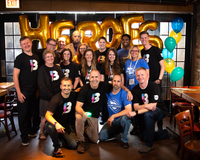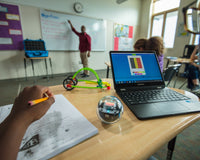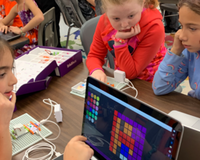There is simply no denying that knowledge of technology, computers, and coding is becoming increasingly critical to many careers in the present and the future. That's why kids benefit from becoming familiar with coding concepts at a young age. Parents are already on board; more than 90% want their kids to learn to code. And with plenty of tools, programs, and activities out there to help with getting started, learning the foundations of coding is easier to grasp than ever before.
Surprisingly, however, kids don't need to use a computer or any type of technology to learn computer science concepts. Unplugged coding activities are an accessible alternative to the traditional way of learning code. We asked five of our Sphero Heroes to share their favorite unplugged coding activities, their benefits, and how you can start teaching these unplugged coding activities in the classroom with your students today.
What Is Unplugged Coding?
Unplugged coding is teaching coding concepts without using devices. It is learning how to code without writing lines of code. When coding unplugged, students use their knowledge to work on computational challenges that will help them understand the concepts they’ll use in coding projects. Jennifer Jensen, Innovation Lab Specialist at Clear Sky Elementary, puts it this way:
“I believe there are two components to unplugged coding activities. The first is the act of using offline activities and games, some of which involve markers, paper, or manipulatives, as a way to teach programming concepts in an engaging and ‘unplugged’ way. The other component to unplugged coding focuses on the computational skills of:
- Decomposition
- Pattern matching
- Abstraction
- Algorithms (or automation)
These activities and games focus more on these four pillars of computational thinking and less on programming.”
Why Is Unplugged Coding Important?
Unplugged coding started in the 1990s because computers in the classroom weren’t as common. However, the use of unplugged coding to teach computational thinking still finds wide adoption these days when there is no shortage of computers in the classroom. Why?
Unplugged coding is important, especially for beginners, because many of the skills they need to write code are ones they have already used or could use outside of the technical sphere. If they dive right into the new world of coding, the complexity of the programming languages and tools may hide this connection.
Coding is more than just writing code, and unplugged coding can help students learn how to think computationally before even writing a single line of code.
Four Benefits of Unplugged Coding Activities
There are many reasons to add unplugged coding to your lesson plans. Here are four benefits of coding without screens:
1. Coding Unplugged Brings More Collaboration
Coding is generally perceived as a solitary activity most of the time. Pair programming and group programming allow for some collaboration, but not compared to solving a coding problem in the physical world. "These activities are best done in small groups, and this means that kids can practice their social skills and work together to solve the problem in front of them," says Bradley Davies, Year 2 Teacher and Head of EdTech at Kämmer International Bilingual School.
2. Unplugged Coding Activities Mean No Electronic Distractions
When students have a tablet or other device in front of them, they can often be distracted by other digital influences. When students are unplugged, they can focus on critical thinking and the problem-solving skills required for coding instead of what else is happening on the device.
3. Unplugged Coding Is an Easier Transition to Robotics
Robots function in the physical world but run on code. By working with physical projects, students will better understand "the actual coding required to operate robots," says Jensen.
4. No Screens Show Concrete Concepts and Results
Programming languages are abstract. Because of this, errors and bugs are often hard to track down. With unplugged coding projects, students can see and experience their successes and failures and learn from them. Paige Bestoff, Digital Tech and Gifted & Talented Teacher at E Raymond Appleby School, gave us an example:
A student may be able to program a loop in an online challenge, but they may not know why they are using loops — especially when teaching the concept of nested loops. Students may not be code-efficient when they are doing online programming, but when they are doing an unplugged activity, using loops shows them more visually and physically how the loops work and why they are more code-efficient.
How To Get Started with Unplugged Coding Activities
To help you get started with unplugged coding, our Sphero Heroes provided us with these games and tips that will help you implement unplugged coding in your classroom. The most common advice from the Heroes is to link coding to other areas of your curriculum. This will allow you to embed core coding principles in your teaching day without a lot of extra planning while helping students to link what they are learning in coding to other subjects they know.
Jensen says, "I focus on the most fundamental elements of computational thinking: decomposition, pattern matching, abstraction, and algorithms (or automation). When I took the time to really dig deeper into these individual elements, I quickly realized how many broader skills I needed to be teaching my students outside of the standard algorithm and block coding."
3-5 Venture Teacher at Wrights Mill Road Elementary Beth Bass added, "I would encourage teachers to keep it simple. Use everyday objects and use the same objects in different lessons. You want students to focus on the skill you are trying to teach them and not keep up with a lot of pieces and learn special rules for materials."
Five Unplugged Coding Activities
There are many activities that don't involve coding to teach coding. Here are some ideas for unplugged coding activities:
1. Sudoku Puzzles
Jensen additionally explains how to use Sudoku for an unplugged coding activity:
The process of creating an “algorithm” to solve one of these puzzles lends itself nicely to computational thinking skills. We begin by using decomposition to begin thinking about the steps that we are going to take. This involves just focusing on one section of the larger square to see which numbers are missing. We then apply pattern matching as we try to identify any patterns in the steps we have already taken to solve the puzzle. We then have abstraction as we begin to remove details that might be too specific, and we start to focus on instructions that will work across multiple puzzles.
2. Stacking Cups
This activity can teach students the connections between actions and symbols. In this activity, a student is given a picture of how cups should be stacked. Then the student writes the directions to build the stack of cups. Another student who has not seen the picture then has to recreate the stack of cups from the written instructions. For more information on this activity, visit My Robotic Friends.
3. Build a Lego Robot
We don't mean using a Lego robot kit. For this activity, use basic Lego blocks. The goal here is to build a robot using Lego blocks from only verbal instructions. One student will have already built a robot and will be the "programmer." That student instructs the other student how to build the same robot without looking at the finished project. From this activity, students will learn about algorithms and sequences.
4. Create Your Own Code
Have students design their own code for sending secret messages. They can take cues from Morse Code, Binary Code, or Caesar Code and use them as a starting point. Then use the code they invented to send secret messages to each other or to embed clues for a treasure hunt. This activity will help them grasp the concept of abstract thinking.
5. Program a Robot with Color
There are several projects, like those mentioned above, you can start doing today to teach unplugged coding concepts to your students. However, unplugged doesn’t necessarily have to mean technology-free. With a screenless programmable robot, like Sphero indi, students can learn valuable computational thinking skills and work on problem solving by building mazes and obstacle courses with a robot that is driven and programmed by color.
Learn more about how indi works and how kids as young as four years old can start learning these skills here.
Wrapping Up: Unplugged Coding Activities in the Classroom
Coding is an important skill for the future and something kids can benefit from by starting learning at an early age. However, they don't always have to write code to pick up the skills they will need. Unplugged coding activities can teach them critical thinking, computational thinking, problem-solving, and the hows and whys of coding. Then they can put all these skills into practice when they are sitting at the computer writing code.
To inspire them with fun hands-on projects once they get back to the computer, explore Sphero's programmable robots, STEAM kits, and computer science curriculum.










